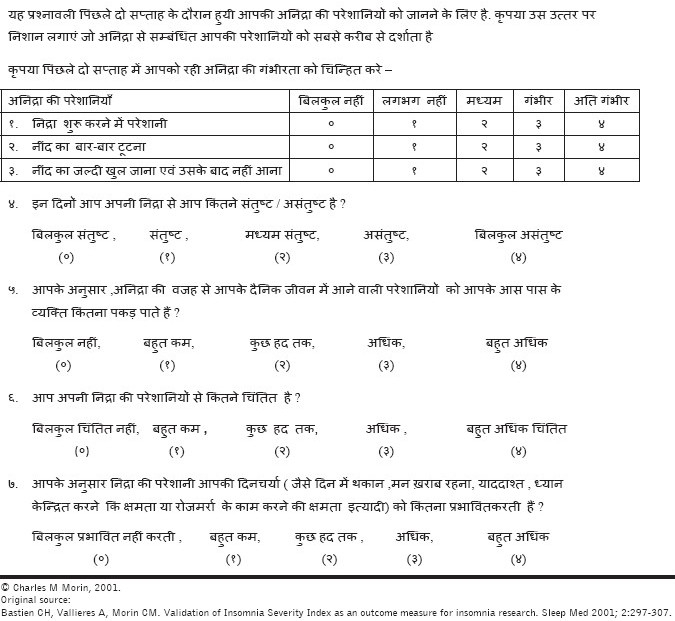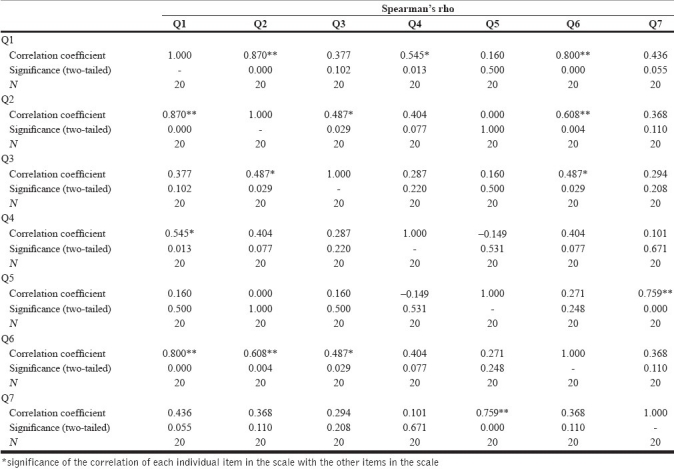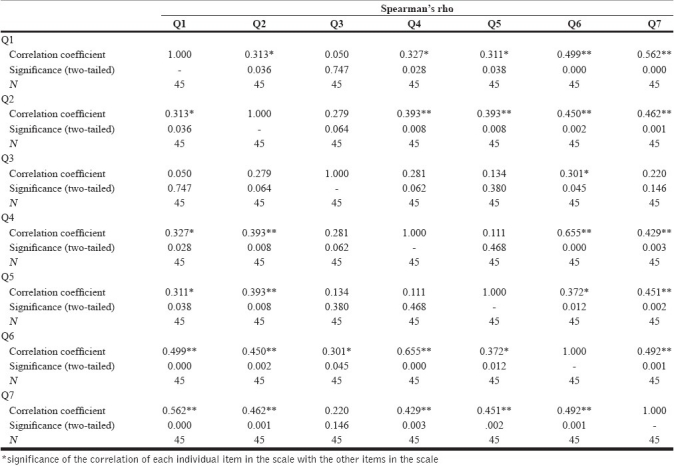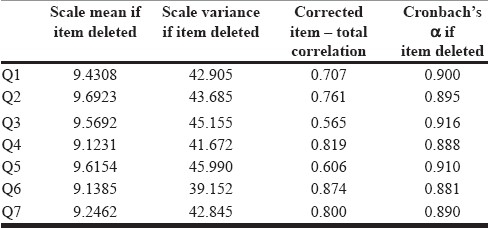Abstract
Aims and Objectives:
Translation of the Insomnia Severity Index from English to Hindi and Validation of the Hindi version.
Materials and Methods:
The translation process of the Insomnia Severity Index was initiated after obtaining due permission from the author of the original version of the same. Translation was carried out by using standard translation procedures, such as combined translation, decentering, and pretest method. The final version of the Insomnia Severity Index in Hindi was finally validated. A randomly selected sample size of 65 subjects was enrolled for the purpose of validation and testing the reliability of Hindi version of the Insomnia Severity Index. Insomnia was present in 45 subjects and they constituted the insomnia group. The rest 20 subjects did not have insomnia and were included in the control group. The Hindi version of the Insomnia Severity Index was applied to both the groups.
Results:
The total sample constituted of 50.8% males and 49.2% females. The mean age in the control group was 30.8±8.3 years and that in the insomnia group was 40.3±4 years (t=3.04; P=0.001). The translated version of the Insomnia Severity Index showed a reliability of 0.91 (Cronbach's α=0.91). This was not just simple translation, but many of the words were changed to adapt it for the local population.
Conclusion:
The Hindi version of the Insomnia Severity Index is a valid and reliable tool that can be administered for the assessment of severity of insomnia.
Keywords: Hindi, insomnia, insomnia severity index, validation
INTRODUCTION
Insomnia is a disorder of sleep that manifest as difficulty in falling asleep, maintaining sleep or nonrefreshing sleep even though conditions are adequate for sleeping.[1] The prevalence of insomnia is widespread and around 30% of the adult population across the world complain of at least one symptom of insomnia, that is, difficulty in falling asleep, maintaining sleep, nonrefreshing sleep.[1] The day-to-day functioning of an individual is influenced by the quality of sleep, and subjects with insomnia have difficulty in maintaining adequate/optimal daytime functioning as these subjects frequently suffer from fatigue, malaise, loss of motivation, and decline in cognitive abilities.[2]
MATERIALS AND METHODS
The translation process of the Insomnia Severity Index from English to Hindi was initiated after taking due consent from the author of the original English version.[3]
Translation procedure
The English version was translated to Hindi by two bilingual experts separately, and version 1 and version 2 were developed. Each item in these two versions was discussed by the translators until a consensus was reached and a third version was developed. This version was back-translated to English by two different bilingual experts, resulting in version 4 and version 5. Discrepancies, if any, between these two versions were discussed and a final back-translated version, version 6, was developed and compared with the original scale. The back-translated version (version 6) was brought as close as possible to the original scale. Corresponding changes were made in version 3, and it was stored as version 7.
A pilot study was conducted by using version 7, and the subjects participating in the pilot study were asked to point out the difficulties they faced in comprehending the items on the scale. The suggestions made during the pilot study were taken into account and another version, version 8, was developed. This version 8 [Appendix 1] was used in the current study.
APPENDIX 1.

The translation being a cross-cultural one, various difficulties were faced and certain modifications in the wordings had to be made, but the contextual meaning of the original version was retained.
The literal meaning of ‘insomnia’ in Hindi is anidra and that of ‘problem’ is paresani, and hence the term anidra ki paresani was used in the column depicting the nature of sleep problems in the first three questions. The original version graded the severity of the first three questions as ‘none’, ‘mild’, ‘moderate’, ‘severe’, and ‘very severe’, whose equivalent in Hindi were chosen as ‘bilkul nahi’, ‘lagbhag nahi’, ‘madhyam’, and ‘gambhir’ and ‘ati gambhir’, respectively, after discussing it with patients.
The first question of the original questionnaire was initially translated as ‘Nidra shuru karne me paresani’. However, the participants of the pilot study had difficulty in comprehending the exact meaning of the question and suggested that it be changed to ‘neend aane me paresani’, ‘neend’ being another word for ‘sleep’ and is more commonly used. The contextual meaning of the original question ‘Difficulty in falling asleep’ remained unchanged.
The second question enquired whether the subjects had any difficulty in the maintenance of their sleep and was translated as ‘soye rahne me paresani’, ‘soye rahne’ denoting ‘sleep maintenance’. However, a few patients failed to understand it, and hence, it was changed to ‘neend ka baar-baar tootna’ in the final version after the pilot study.
The third question of the Insomnia Severity Index was framed as ‘Problem waking up too early’ in the original version, and this was initially translated as ‘neend ka jaldi khul jana’. However, the subjects of the pilot study had difficulty comprehending the difference between the second and the third question. After the difference between these two questions were explained to the subjects, they suggested that it be changed to ‘neend ka jaldi khol jana evam uske bad nahi ana’, which meant ‘waking up earlier than the usual waking time and inability to fall asleep again’.
The fourth question of the Insomnia Severity Index measured how satisfied or dissatisfied the subjects were with their present sleep pattern and the answers were graded as ‘very satisfied’, ‘satisfied’, ‘moderately satisfied’, ‘dissatisfied’, and ‘very dissatisfied’. These were translated as ‘bilkul santusht’, ‘santusht’, ‘madhyam santusht’, ‘asantusht’, and ‘bilkul asantusht’. The main question was translated as ‘in dino aap apni nindra se kita santust/asantust hai?’
The fifth question intends to ask about the impairment in quality of life owing to insomnia, as perceived by persons close to the sufferer. However, literal translation of quality of life was difficult to understand by our subjects and they suggested a simplified language. Hence, we changed it to ‘anidra ki wajah se aapke dainik jeevan menin aane wali pareshaniyaan’, that is, ‘impairments that the sufferer is facing in daily activities because of insomnia’.
The sixth question enquired how worried/distressed the subject was about his current sleep problems. This was translated as ‘aap apne nidra ke paresaniyo se kitna chintit hai’, ‘kitna’ meaning the ‘magnitude’ and ‘chintit’ meaning ‘worried/distressed’. The responses in the original questionnaire were graded as ‘not at all worried’, ‘a little’, ‘somewhat’, ‘much’, and ‘very much worried’, the equivalent of which in Hindi were ‘bilkul chintit nahi’, ‘bahut kam’, ‘kuch had tak’, ‘adhik’, and ‘bahut adhik chintit’.
The seventh question enquired how adversely the subject's daily functioning (e.g., daytime fatigue, mood, ability to function at work/daily chores, concentration, memory, and mood) has been interfered with by his current sleep problems. The responses were graded as ‘not at all interfering’, ‘a little’, ‘somewhat’, ‘much’, and ‘very much’.
Statistical analysis
The statistical analysis for measuring the reliability and validity of the Hindi version of the Insomnia Severity Index was carried out by using the SPSS 17.0 Version. For comparison of nonparametric data, χ2 analysis was done. The t test was used to compare continuous variables between both groups. Spearman's correlation coefficient was used to assess correlation between different items of a scale. Reliability analysis was done by using Cronbach's alpha.
RESULTS
In this study, the total sample was composed of 65 subjects. Among these, 50.8% subjects were males and 49.2% were females. Insomnia was present in 45 subjects and the remaining 20 subjects were included in the control group. Female participants were more in the insomnia group (females 57.8%) as compared with the control group (male 70%) (χ2=4.27; P=0.04). The mean age of subjects in the control group was 30±8.3 years and that in the study group was 40.3±14 years (t=–3.04; P=0.001).
The distribution of comorbid conditions in the subjects with insomnia were major depressive disorder 40.0%, restless leg syndrome 24.4%, and other psychiatric diagnosis 8.9%, and the rest were having complaints of primary insomnia. The correlation between various questions was calculated by using Spearman's correlation, and most of the items were strongly correlated [Tables 1 and 2] for both the control group and the insomnia group. The analysis of the reliability of the Hindi scale was done by using Cronbach's alpha, the value of which for the whole scale was 0.91 and this did not change much even after the deletion of any of the item on the scale [Tables 3 and 4].
Table 1.
Correlations among various items of hindi version of insomnia severity index in the control group

Table 2.
Correlation among various items of hindi version of insomnia severity index in the insomnia group

Table 3.
Reliability statistics

Table 4.
Item – Total statistics

DISCUSSION
The Insomnia Severity Index was translated to Hindi with the aim of proper evaluation of severity of insomnia in the general Indian population. Cross-cultural translation has its own set of limitations (e.g., availability and accessibility of bilingual translators). Brislin's back-translation method is the most widely used translation procedure in cross-cultural translation. However, it is not the gold standard, and a combination of various translation methods is more appropriate that we have used.[4] A combination of translation techniques such as combined translation, pretest method, and decentering was adopted to translate the Insomnia Severity Index to Hindi. In cross-cultural translation, it is difficult to directly translate contents of the original version to the translated version. To overcome this problem, the decentering procedure can be availed of, wherein the translated version need not be an exact copy of the original version but the contextual meaning of the original content has to be maintained.[4] The decentering procedure was used in our translation at various stages. The second question of the Insomnia Severity Index dealt with the problem of ‘Difficulty in maintaining sleep’, and the translated version in Hindi meant ‘Frequent awakenings at night’. People with insomnia often wake up earlier than their scheduled waking time and have difficulty in falling back to sleep again. This was the problem that the third question of the Insomnia Severity Index intended to evaluate and was framed in the English version as “problem waking up early’. To make it more easier to comprehend, we translated it as ‘waking up prior to usual waking time and difficulty falling asleep again’. The fifth question of the Insomnia Severity Index enquired how perceivable to others was one's impairment in the ‘quality of life’ due to the subject's insomnia problem. The quality of life encompasses a broad array of domains of a person's life. Hence, the quality of life was substituted with a more general term ‘impairment in daily activities’.
The Insomnia Severity Index that was translated to Arabic had an internal consistency reliability of 0.84 and an item to Insomnia Severity Index correlation range of 0.49-0.92.[5] The Hindi version of the Insomnia Severity Index had a reliability of 0.91 and a corrected item correlation range of 0.56–0.87.
In conclusion, Hindi version of the Insomnia Severity Index is a valid and reliable tool for the measurement of severity of insomnia.
ACKNOWLEDGMENT
We acknowledge Charles M. Morin, PhD, Université Laval, for granting us the permission to translate the Insomnia Severity Index in Hindi.
Footnotes
Source of Support: Nil
Conflict of Interest: None.
REFERENCES
- 1.Roth T. Preface. Sleep Med Clin. 2006;1:13–4. [Google Scholar]
- 2.Chiong TL. Foreword. Sleep Med Clin. 2006;1:11–2. [Google Scholar]
- 3.Bastien CH, Vallieres A, Morin CM. Validation of insomnia severity index as an outcome measure for insomnia research. Sleep Med. 2001;2:297–307. doi: 10.1016/s1389-9457(00)00065-4. [DOI] [PubMed] [Google Scholar]
- 4.Cha ES, Kim KH, Erlen JA. Translation of scales in cross-cultural research: Issues and techniques. J Adv Nurs. 2007;58:386–95. doi: 10.1111/j.1365-2648.2007.04242.x. [DOI] [PubMed] [Google Scholar]
- 5.Suleiman KH, Yates BC. Translating the insomnia severity index into Arabic. J Nurs Scholarsh. 2001;43:49–53. doi: 10.1111/j.1547-5069.2010.01374.x. [DOI] [PubMed] [Google Scholar]


